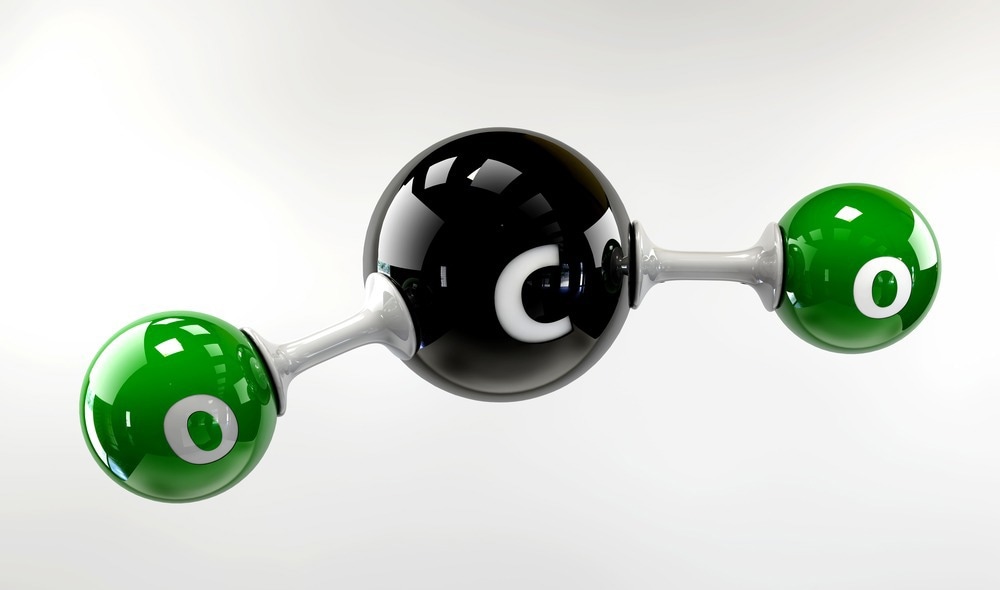For electrolytic reduction of carbon dioxide (CO2), copper (Cu) distributed on 2D materials demonstrates outstanding catalytic activity. In a paper published in The Journal of Physical Chemistry C, a new kind of 2D nanoscale catalyst was developed by mounting clusters of copper on defective diamond graphene.

Study: Anchoring Cu Clusters over Defective Graphene for Electrocatalytic Reduction of CO2. Image Credit: Victor Josan/Shutterstock.com
Addressing the Ever-Increasing CO2 Content in the Atmosphere
Carbon dioxide (CO2) is the most well-known greenhouse gas and a principal contributor to the drastic climate change which has taken the world by storm. Therefore, collecting and recycling CO2 into value-added goods and fuels is critical.
CO2 is primarily produced by the burning of fossil fuels and petrochemical refineries, as well as the cement, iron, and steel production industries. Without a doubt, the contribution of CO2 toward the greenhouse effect and global warming is unmatched.
One possible approach to establishing a balanced carbon cycle is to utilize CO2 as a carbon-containing resource for manufacturing valuable organic substances such as methanol and methane. CO2 may be transformed into a number of carbon-based materials using processes like electrochemical, photochemical, and biological reduction.
CO2 Reduction Reaction Needs a Catalyst
The electrochemical reduction process of CO2 shows good reaction speeds and CO2 transformation rates. Nonetheless, CO2 molecules have a non-polar linear makeup and are chemically inert and thermodynamically stable. This high stability necessitates extreme temperature and pressure settings for its electrochemical reduction procedure.
CO2 may be activated by using appropriate catalysts. So, developing an effective CO2 reduction reaction catalyst with excellent product specificity and minimal overpotential is urgently needed.
Benefits of Using Copper Catalysts
Different materials, including transition metals, precious metals, and metallic oxides, have been explored for the catalysis of CO2 reduction reactions. Copper (Cu) is a nontoxic transition metal, abundantly available, highly selective and an effective catalyst.
Various kinds of copper materials can be used to generate oxygenates and hydrocarbons, applying different potentials. The electrochemical reduction reaction of CO2 using raw Cu requires a significant overpotential, making the process highly energy intensive.
The set of proton-coupled electron-transference steps may be successfully enhanced by modifying the copper-based nanoarchitecture, considerably increasing catalytic performance.
Copper catalysts generate a broader spectrum of products than other metal-based catalysts because of how electrocatalytic performance is affected by the magnitude of clusters and exposure to air.
For optimizing the structure of the electrocatalyst and adjusting exposure to air, surface nanostructuring and regulated electrophoretic deposition are known to be effective techniques. Such catalysts could well prove to be suitable for industrial manufacturing.
Graphene Platforms can Enhance Copper's Catalytic Effects
Ever since graphene was discovered, this sophisticated 2D material has been the focus of research in catalyzed conversion and energy storage. The controlled transformation of ethyne to ethene may be achieved by depositing copper atoms onto faulty diamond graphene.
The exposed fraction of the Cu clusters and the hardness of the composite depend on the copper-carbon bond's distinctive structure. Efficient electron transfer may enhance the catalytic performance of the unsaturated coordination spots.
What Did the Researchers Do?
In this study, the team developed copper clusters that could be firmly attached to defective nanodiamond graphene. The copper atoms were distributed on 2D materials and could be employed as a unique CO2 reduction reaction catalyst.
The team believed that testing procedures would allow control of the aggregating mechanism and quantity of the attached copper clusters on the graphene platform to satisfy the demands of practical manufacturing.
Important Findings
Copper clusters with varied atomic numbers and interaction mechanisms will yield diverse catalyzed products. Inverted triangle Cu3/ND@G and triangular Cu4/ND@GR accelerated the CO2 reduction reaction with analogous active sites and almost identical intermediates and path trends.
The adsorption capability of CO* intermediates is critical in the generation of various CO2 reduction reaction products. CO* has a poor capacity to attach to the catalytic material on Cu2/ND@G, and the CO* species break down into hazardous carbon monoxide gas. In comparison, CO* has a great binding capacity to the catalytic material in Cu3/ND@G and will not detach, which leads to its thorough reduction into organic molecules.
The capability of the oxygen atoms to link with the catalytic material is critical for the formation of methanol or methane. Methanol will form if the carbon-oxygen linkage in the intermediate has significant binding potential. By modifying the stepped voltage amount, byproduct formation may be decreased.
The researchers predicted that this work could add to the existing group of CO2 catalysts, expand the applications of graphene-supported transition metals, and offer a variety of concepts for developing novel CO2 reduction reaction catalysts.
Reference
Du, D., Zhu, H. et al. (2022). Anchoring Cu Clusters over Defective Graphene for Electrocatalytic Reduction of CO2. The Journal of Physical Chemistry C. Available at: https://pubs.acs.org/doi/10.1021/acs.jpcc.2c03551
Disclaimer: The views expressed here are those of the author expressed in their private capacity and do not necessarily represent the views of AZoM.com Limited T/A AZoNetwork the owner and operator of this website. This disclaimer forms part of the Terms and conditions of use of this website.